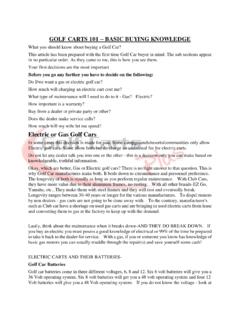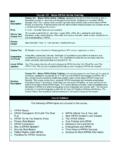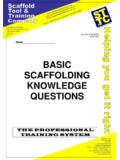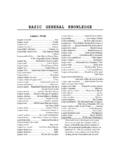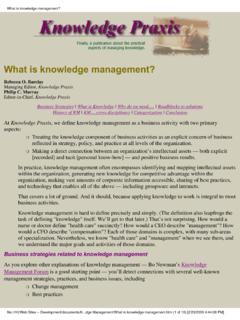Transcription of 50 MATHCOUNTS LECTURES (24) COMBINATOTICS BASIC …
1 50 mathcounts lectures (24) COMBINATOTICS 52 BASIC knowledge 1. Terms A permutation is an arrangement or a listing of things in which order is important. A combination is an arrangement or a listing of things in which order is not important 2. Definition The symbol ! (factorial) is defined as follows: 0! = 1, and for integers n 1, n!= n (n 1) 1. 1! = 1, 2! = 2 1=2, 3! = 3 2 1=6, 4! = 4 3 2 1 = 24, 5! = 5 4 3 1 1 = 120, 6! = 6 5 4 3 2 1 = 720.
2 3. Permutations (1). Different elements, with no repetition. Take r elements each time from n distinct elements (1 r n). Number of permutations )!(!),(rnnrnP (1) (2). n distinct objects can be permutated in n! permutations. We let n = r in (1) to get P(n, n) = n! (2) Proof of (2): 50 mathcounts lectures (24) COMBINATOTICS 53 The first object can be chosen in n ways, the second object in n 1 ways, the third in n 2, etc. By the Fundamental Counting Principle, we have n(n 1)(n 2) 2 1 = n!
3 Ways. Example 1. In how many ways can the letters of the word MATH be arranged? ( MATHCOUNTS Handbooks) Solution: 24. 4! = 4 3 2 1 = 24. (MATH MAHT MTAH MTHA MHTA MHAT AMTH AMHT ATMH ATHM AHTM AHMT TAMH TAHM TMAH TMHA THMA THAM HATM HAMT HTAM HTMA HMTA HMAT) Example 2: In how many different orders can a group of six people be seated in a row of 6 seats? Solution: 24. 6! = 6 5 4 3 2 1 = 720. Try it yourself: (1). In how many ways can the letters of the word COUNTS be arranged? Answer: 720 (ways) (2).
4 How many different four-digit, positive integers are there where each digit is a prime number? No digit is allowed to be used twice in any integer. Answer: 24(integers) 4. Grouping THEOREM: Let the number of different objects be n. Divide n into r groups A1, A2, .., Ar such that there are n1 objects in group A1, n2 objects in group A2, .., nr objects in the group Ar, where n1 + n2 + + nr = n. The number of ways to do so is 50 mathcounts lectures (24) COMBINATOTICS 54 !
5 !!!21rnnnn (3) Proof: (1). There are 1nn ways to take out n1 elements from n elements to form group A1. (2). There are 21nnn ways to take out n2 elements from n n1 elements to form group A2. (3). Continue the process until there are nr elements left to form group Ar. (4). The total number of ways, based on the Fundamental Counting Principle, is 1nn 21nnn .. rrnn = !!!!21rnnnn Example 1: In how many ways may we distribute 12 books to Alex, Bob, Catherine, and Denise such that each person gets 3 books?
6 Solution: 369600)!3(!12!3!3!3!3!12!!!!421 rnnnn Example 2: In how many ways may we distribute 12 books to Alex, Bob, Catherine, and Denise such that Alex and Bob each get 4 books and Catherine and Denise each get 2 books? Solution: 3207900. 3207900!2!2!3!3!12!!!!21 rnnnn Example 3: In how many ways may we distribute 12 books to Alex, Bob, Catherine, and Denise such that Alex gets 5 books, Bob each get 4 books, Catherine gets 3 books, and Denise gets 2 books? 50 mathcounts lectures (24) COMBINATOTICS 55 Solution: 83160 83160!
7 1!2!4!5!12!!!!21 rnnnn THEOREM: Let there be r types of objects: n1 of type 1, n2 of type 2; etc. The number of ways in which these n1 + n2 + + nr = n objects can be rearranged is !!!!21rnnnn (4) The proof is the same as the proof for (3) Example 1. In how many ways may the letters of the word Mississippi be permutated? Solution: The word Mississippi has 4 i s, 4 s s, 2 p s, and 1 m. 34650!1!2!4!4!11!!!!21 rnnnn Example 2. In how many ways may the letters of the word Mississippi be permutated in such a way that two p s are not next to each other?
8 Solution: 28350. We tie two p s together and think of it as one letter and subtract the number of ways the resulting word can be permutated from 34650, the total number of ways the original word can be permutated. The number of permutations of the 10 letters is 6300!1!1!4!4!10!!!!21 rnnnn The number of permutations sought is 34650 6300 =28350. Example 3. In how many ways may the letters of the word MASSACHUSETTS be permutated? Solution: 64864800. 50 mathcounts lectures (24) COMBINATOTICS 56 There are now 13 distinguishable objects, which can be permuted in 13!
9 Different ways. However, we must divide this accordingly. AA, SSSS, TT, M, C, H, E, U. !2!4!2!13!1!1!1!1!1!2!4!2!13 N= 64864800. Example 4. In how many ways may we permute the letters of the word MASSACHUSETTS in such a way that MATH is always together, in this order? Solution: 151200 We tie the four letters MATH together and consider them as one letter with the remaining 9 letters: SSSS, A, C, U, E, and T. The total number of permutations is !4!10!1!1!1!1!1!1!4!10 N= 151200 Try it yourself: (1).
10 How many distinguishable arrangements are possible using all of the letters of BREEZE? ( MATHCOUNTS Competitions) Answer: 120(arrangements) (2). How many different arrangements are there using all of the letters in the word PARALLEL? ( MATHCOUNTS Competitions) Answer: 3,360(arrangements) (3). How many distinct ways can the letters of the word PEOPLE be arranged so that the two P s are together and the two E s are together? ( MATHCOUNTS Competitions) Answer: 24 50 mathcounts lectures (24) COMBINATOTICS 57 (4).
